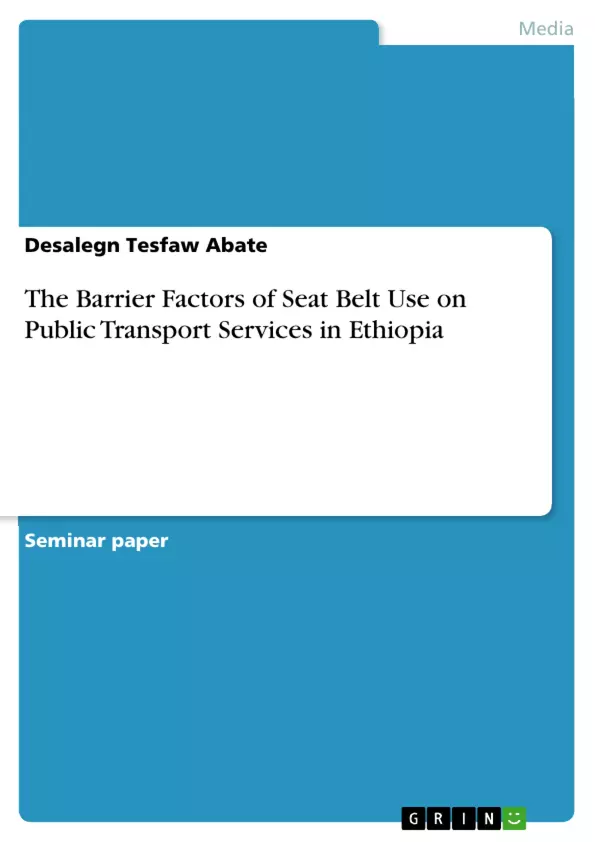The objective of this study was to investigate the barrier factors of seat belt use on public transport services in selected city administration in Amhara region. This study used simple random sampling technique to select 223 samples whereas data was collected with the help of questionnaire and personal observation. In order to analyze data, descriptive statistics with the help of SPSS 16.0 version were used.
The findings of the study show that more than 83,5% of the drivers are using seat belt with different reasons. Furthermore, there is a significant relationship between perceived susceptibilityand severity of road traffic accident, perceived benefits of seat belt use and cues to action with seat belt use. On the other hand, drivers’ demographic factors have no significant relationship with seat belt use. Moreover, due to unavailability of functional seat belts, negligence of drivers, poor enforcement of laws on seat belt use, discomfort and lack of awareness on the importance of using seat belts are the major barrier factors that discourages drivers to use seat belt.
As a recommendation, the concerned government offices should develop and implement strong enforcement law and change the attitude of drivers to keep the life of drivers and passengers as well as the properties of the community.
Inhaltsverzeichnis (Table of Contents)
- Introduction
- Statement of the Problem
- Research Questions
- Objectives of the Study
- Review of Related Literatures
- The Health Belief Model (HBM)
- Seat belt use
- Perceived Susceptibility to road traffic accident related injury or death
- Perceived benefits of seat belt use
- Perceived barriers to use seat belts
- Cues to Use Seat Belts
- Methodology of the Study
- Research Result and Discussion
- Conclusion
- Recommendation
- References
Zielsetzung und Themenschwerpunkte (Objectives and Key Themes)
This study aims to investigate the barrier factors preventing drivers from using seat belts on public transport services in selected city administrations in the Amhara region of Ethiopia. It seeks to understand the reasons behind the low seat belt use rates in the region and identify key factors influencing drivers' decisions regarding seat belt usage.
- The relationship between sociodemographic factors of drivers and seat belt use.
- The impact of perceived susceptibility and severity of road traffic accidents on seat belt use.
- The influence of perceived benefits and barriers associated with seat belt use.
- The role of cues to action in promoting seat belt use.
Zusammenfassung der Kapitel (Chapter Summaries)
- Introduction: The chapter sets the context by highlighting the global variation in seat belt usage rates, with lower rates in developing countries compared to developed nations. It emphasizes the importance of regular global assessments of road safety and the need for evidence-based decisions. The chapter introduces the Ethiopian context, emphasizing the low seat belt use rates and the need for research to address the issue.
- Statement of the Problem: This chapter delves into the problem of low seat belt use in Ethiopia, highlighting the efforts made by the government through social marketing campaigns to promote seat belt usage. Despite these efforts, drivers remain reluctant to use seat belts. The chapter emphasizes the significant social and economic consequences of traffic accidents and the importance of seat belts as a vital safety measure. The lack of research on this specific issue in Ethiopia is highlighted.
- Research Questions: This chapter outlines the key research questions guiding the study. It explores the relationship between driver demographics and seat belt use, investigates the perception of susceptibility and severity related to road traffic accidents, and analyzes the perceived benefits and barriers associated with seat belt use. Additionally, it examines the association between cues to action and seat belt usage.
- Objectives of the Study: This chapter outlines the general and specific objectives of the study. The study aims to identify and describe the barrier factors related to seat belt use in public transport services. Specific objectives include determining the relationship between driver demographics and seat belt use, measuring the impact of perceived susceptibility and severity on seat belt use, identifying the perceived benefits of seat belt use, and describing the association between cues to action and seat belt usage.
- Review of Related Literatures: This chapter introduces the Health Belief Model (HBM), a social cognition model that explains individuals' health-related decisions. The chapter discusses the application of the HBM in developed countries and the limited research on its implications in developing countries like Ethiopia. It also reviews existing research on seat belt use in different countries, highlighting the trends and factors influencing usage. Notably, the chapter highlights the lack of studies on seat belt use in Ethiopia.
Schlüsselwörter (Keywords)
This study focuses on seat belt use, road safety, health belief model, psychological factors, public transport, and driver behavior in the context of Ethiopia. The research explores the perceived susceptibility, severity, benefits, and barriers associated with seat belt use, drawing upon the Health Belief Model to understand drivers' decision-making processes.
- Quote paper
- Desalegn Tesfaw Abate (Author), 2018, The Barrier Factors of Seat Belt Use on Public Transport Services in Ethiopia, Munich, GRIN Verlag, https://www.grin.com/document/427507



